Throws in Karate?
by Joe Swift
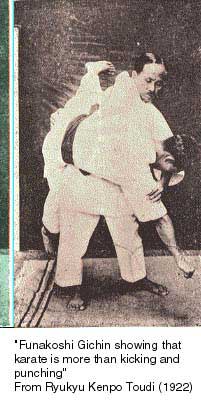 The mere mention of the word "karate" conjures up many images to the listener,
the most common probably being that of two combatants fighting each other
with kicks and punches. However, this image seems to stem from the training
methods and practices adopted by modern karate, and is not necessarily
a true representation of the older Okinawan methods. In fact, karate is
more of a complete self defense system than most non-practitioners realize,
incorporating not only strikes, punches, and kicks aimed at the body's
most anatomically vulnerable areas, but also joint locks, takedowns, throws,
strangulations, restraints, etc.
The mere mention of the word "karate" conjures up many images to the listener,
the most common probably being that of two combatants fighting each other
with kicks and punches. However, this image seems to stem from the training
methods and practices adopted by modern karate, and is not necessarily
a true representation of the older Okinawan methods. In fact, karate is
more of a complete self defense system than most non-practitioners realize,
incorporating not only strikes, punches, and kicks aimed at the body's
most anatomically vulnerable areas, but also joint locks, takedowns, throws,
strangulations, restraints, etc.
This article will focus its attention to one all-but-forgotten aspect
of karate application, namely throwing techniques.
Specific mention of throwing techniques in karate can be found as far
back as 1922, in the first known published book on the art, Funakoshiís
classic Ryukyu Kenpo Toudi. This book nominated eight throws, with specific
mention that at least two of them were applications from kata described
in the book. Funakoshiís next two books, Rentan Goshin Toudijutsu (1925)
and Karatedo Kyohan (1935), also contained examples of throws and takedowns.
One other book worth taking a look at is the 1938 collaborative publication
entitled Kobo Kenpo Karatedo Nyumon by Mabuni Kenwa and Nakasone Genwa.
In addition to describing many throws and takedowns, Mabuni also states
that the karate that was introduced to Tokyo (Mabuni lived/taught in Osaka)
was only a single portion of a larger whole, and that the fact that people
in Tokyo viewed karate as a solely striking and kicking art only served
to point out their overall lack of awareness of the complete nature of
karate (Mabuni et al, 1938).
More often than not, throws are not implicit in the kata techniques, but
serve more as follow ups or "exit techniques" after the necessary set-up,
or "entry technique" has been established through strikes. One general
rule of thumbs for throwing in general is to first damage the opponent
with strikes, so as to lessen the chances for resistance (Kinjo, 1991).
Senior American karate teacher Dan Smith, who has spent considerable time
learning karate at the "source" in Okinawa, from numerous teachers, recently
observed the following:
"The question was why didn't the kata show the full follow through on
throws in the kata. I asked the question while on Okinawa of several senior
teachers. Their unanimous answer was that the throws in Okinawan karate
are not meant to throw the opponent anywhere but the ground. Secondly,
it is not appropriate to think you can throw someone far when you have
already struck them and at the point of throwing or tripping them to the
ground they should already be headed that way. . . If you follow the bunkai
of the kata the throws are proceeded by striking techniques, which should
eliminate the ability to off balance the opponent and use their momentum
to throw them very far from where you are." (Smith, 1999)
Let us now take a look at some specific throws found in karate kata.
From Kusanku, Passai, Pinan Godan, Seiyunchin, Chinto, etc.
This particular throwing technique that can be utilized in response to
many types of attack, including a straight punch to the facial area, a
wrist grab, an attempted lapel or throat grab, etc. Thus, as the method
of entry depends upon what type of attack is being defended against, this
description will not cover a specific entry into the technique, but rather
explain the actual technique itself.
This technique is actually an application of a position found in most,
if not all, versions of Kusanku, as well as in Passai, Chinto, Pinan Godan,
Seiyunchin, and several other kata. This posture goes by many names, such
as Manji-gamae, Tettsui-gamae, Ura-gamae, etc., and comes in many variations.
It is represented by one hand in a low position in front of the performer
and the other hand raised up either above the forehead or behind the head.
Some kata use an open hand, others a closed fist, and the stance also
often changes between kata and/or variations. However, the fundamental
principle remains the same.
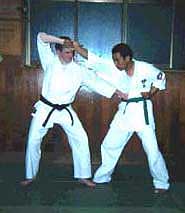
Photograph 1. The
application of the posture. The right hand pulls the opponent's right
hand to break his balance as the left hand strikes into the lower body.
Possible kyusho targets are denko (GB-24) or inazuma (Liv-13). The idea
here is to inflict damage on the opponent before throwing.
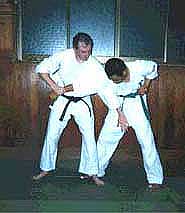
Photograph 2. Step
in front of the opponent's right leg, and slap the testicles with the
left hand to inflict more damage and to get the opponent to bend forward.
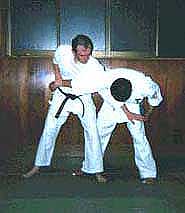
Photograph 3. Controlling
the opponent's left hand, apply pressure to the Golgi receptors at the
back of the tricep tendon (kyusho name hiji-tsume, TW-11), and
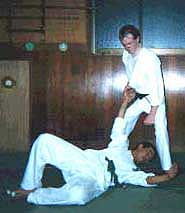
Photograph 4. Turning
the hips to the right, throw the opponent down. Possible follow ups can
include a well placed strike or kick, a joint lock, or similar technique
of subjugation.



From Kururunfa
This throw is actually described in Mabuni and Nakasoni's 1938 Karatedo
Nyumon, page 208. It is an application against a full nelson hold from
behind. Below is an English translation of the instructions, with accompanying
line drawings from the book.
Ura-nage (Throw to the Rear)
When the opponent grabs you in a full-nelson by inserting his hands under
your armpits, before he can get set, immediately bring both arms up, backs
of the hands facing each other, and strike down with your elbows with
all your strength (as if performing a descending elbow smash).
The opponent's grip should loosen, and you should then head-butt him in
the face (if the opponent has gotten you in a deep full-nelson, your head-butt
will probably strike him in the throat or the chest). Sink your body down,
grab the back of his knees with your hands, and topple him backwards by
striking again with the back of your head.
Note: Be sure to keep your mouth open when you perform the rear head-butt,
as if you close it, you run the risk of numbing your eyes (temporary blindness
ñ tr).
In closing, I would like to share a personal anecdote. Showing a copy
of a Japanese translation of the Bubishi to my current teacher, we were
looking at the 48 self defense techniques presented therein. After a few
minutes, he looked at me, and said, "Letís get out on the dojo floor."
He proceeded to demonstrate (on me!) several takedowns and grappling techniques
that were almost verbatim from the Bubishi. I asked him where he learned
them. His reply: "Jujutsu."
Bibliography
Funakoshi, G. (1922) Ryukyu Kenpo Toudi. Tokyo: Bukyosha (Reprinted edition,
1994, Naha: Yoju-shorin)
Funakoshi, G. (1925) Rentan Goshin Toudijutsu. Tokyo: Kobundo. (Reprinted
edition, 1996, Yoju-shorin)
Funakoshi, G. (1935) Karatedo Kyohan. Tokyo: Okura Kobundo.
Kinjo H. (1991) Yomigaeru Dento Karate (A Return to Traditional Karate)
Vol 3 (video presentation). Tokyo: Quest Productions.
Mabuni K. and Nakasone G. (1938) Kobo Kenpo Karatedo Nyumon. Tokyo: Kobukan.
(Reprint edition, 1996, Naha: Yoju-shorin)
Smith, D. (1999) E-mail Post to Cyber Dojo
Photo Credits:
All old photographs in this article were provided by Mr. Takeishi Kazumi
of Yoju Shorin Bookstore in Okinawa. I would also like to personally thank
my dojo-mate Mr. Matsumoto, for posing in the other photographs, as well
as my teacher Uematsu Yoshiyuki Sensei, for the use of his dojo when shooting
the photos.
About the Author:
Joe Swift, native of New York State (USA) has lived in Japan since 1994.
He holds a dan-rank in Isshinryu Karatedo, and also currently acts as
assistant instructor at the Mushinkan Shoreiryu Karate Kobudo Dojo in
Kanazawa, Japan. He is also a member of the International Ryukyu Karate
Research Society and the Okinawa Isshinryu Karate Kobudo Association.
He currently works as a translator/interpreter for the Ishikawa International
Cooperation Research Centre in Kanazawa. He is also on the Board of Advisors
for FightingArts.com.
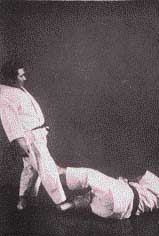
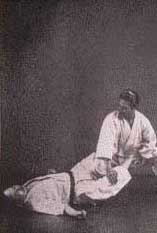
Two of Mabuni Kenwa
(from his 1938 book Karatedo Nyumon)
His partner in the photos is Taira Shinken.
|